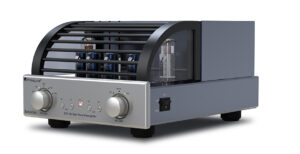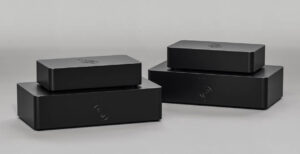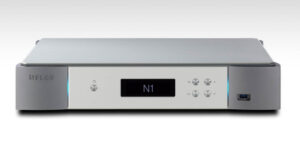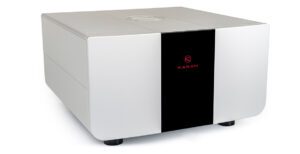
When you attend audio shows around the world, you get to see distinct patterns and trends in system matching. When Product X works so well with Product Y and Product Z that they are used together in shows in two or more continents, you can guarantee those products are a good match. But, few of these exercises in international system matching are as consistent as the use of Aavik electronics, with Ansuz cables and system tuning components, and Raidho loudspeakers. If you tour the shows and the demonstration rooms of dealers around the globe, this Nordic triumvirate is almost always seen together.
In no small part, this comes down to the three brands being sub-sets of Dantax A/S, a Danish audio enterprise group. Raidho – like fellow speaker brand Scansonic and TV furniture company Harmony – are intrinsically linked with Dantax, while Aavik and Ansuz are associated with the group. Nevertheless, the three are in lock-step.
You do see Raidho loudspeakers and Ansuz components used in other systems, but it’s rare to see the Aavik U-300 Unity integrated amplifier out in the wild without Ansuz and Raidho in tow. This is understandable, but unfortunate: the Aavik U-300 might get a reputation for being the ‘also ran’ in the line-up, where in reality it’s possibly the star of the show. If you do get to hear it beyond partnering with ‘The Usual Suspects’, it shows precisely what it has to offer, and it offers a heck of a lot! The Aavik U-300 is the amp needed to develop the latest ranges of Raidho loudspeakers, that require a lot of high-grade power, but it’s no engineer’s folly, no development platform, and definitely no slouch!

In fact, the Aavik U-300 Unity started out as the answer to a growing problem in today’s audio world: space management without sonic compromise. Whether it’s due to shrinking room sizes in Europe, or a growing reluctance to invest in a range of electronics boxes, the Aavik is part of a movement that sees turning the DAC, phono stage, preamp, external power supplies and power amplifiers of old into one, very high performance integrated design.
Taken at face value, this is nothing new and audio companies have been making integrated amplifiers since the 1970s. Moreover, even the high-end has moved from dismissal to tolerance, acceptance, and finally enthusiasm toward one-box solutions. Where Aavik scores is it started out with a clean sheet and considered the amplifier as a single unit from the outset.
That ‘clean sheet’ part is pivotal, because Aavik didn’t start the project with any baggage regarding design inside and out. A big part of this (both in terms of industrial and electronic design) is the volume control, mounted in the centre of the elegant matt-black amplifier. The volume control (which also doubles as a source selector and can be used with the three buttons to control aspects of the amp’s functionality) works entirely in the digital domain. It is out of signal until it registers the user adjusting the volume level, only to go back to sleep once the volume adjustment is completed.
It’s also a Class D design. Collectively, we need to get over the bias against Class D, and an increasing group of manufacturers (including Jeff Rowland and Mola-Mola) are making the sonic case for Class D with great eloquence. The Aavik joins this cool-running revolution. The key point in all things Class D seems to be channelling The Fun Boy Three and Bananarama, with their 1982 hit ‘It Ain’t What You Do (It’s The Way That You Do It)’: Class D can sound remarkable, so long as the implementation steps up to the challenge. And it’s here where the Aavik U-300 Unity shows its mettle. The amplifier is designed with careful grounding in mind (understandable given the Ansuz connection) and its clever use of passive components with high performance Class D modules not only spells great sound, but surprising amounts of power delivery. The amplifier can deliver 300W into eight ohms, but – and this is rare for a Class D design – double that power to 600W into a four ohm load.
Back to that ‘volume’ control. Freed from the tyranny of having a legacy of product design to cope with, Aavik went for an elegant solution that combines minimalism with a surprising degree of flexibility. Aside from a power-off switch on the rear of the amplifier, the controls are limited to three push buttons on the top of the centre cylinder, and that volume dial. Meanwhile, the ‘light show’ comprises a set of LEDs flanking the left and right side of the dial and one at the top of the dial to show the amp is switched on (in standby mode, pressing the button in the middle top of the cylinder turns off all the other LEDs and reduces power to this one, so it glows faintly). In typical operation, the display on the right denotes which input is in use, the one of the left shows volume in 80 steps from -100dB to 0dB. The left button on the top operates mute, but press and hold this button to choose one of three gain settings for an individual source, using the main control knob. The right hand button typically controls navigation (source selection), but press and hold this button and you go into remote control pairing mode. Aavik recommends the standard slim Apple remote to control the U-300.
Press and hold both left and right buttons in a three second ‘power chord’ and the amp switches to adjusting the cartridge loading for the built-in phono stage. The steps on the left side of the display denote impedance, ranging from 50Ω at the -80dB setting up to 5kΩ at the 0dB setting. Combine this with the gain setting and you can get a good match with most cartridges, although Aavik makes no differentiation between moving coil and moving magnet. Nevertheless, setting the cartridge loading without the Aavik manual in hand is difficult, because the booklet acts as decoder ring; you would never know that -55dB equates to 400Ω without the manual.

The manual is an eight-page affair that covers all the basic requirements of operating and using the Aavik U-300 Unity. Its rear panel is split between digital and analogue sides, with the power supply inlet at the centre of the rear panel. To the left, there are two RCA S/PDIF digital connectors, then two Toslink optical connecters and a single USB Type B (UAC 2 compliant) input and a further USB for updates. The right side has three RCA line inputs and a RCA phono input pair. A set of five-way fingertip-stripping Delrin speaker terminals per side flank these input blocks. These use the non-standard white and black indications for positive and negative terminals.
The amplifier itself looks remarkable, thanks in part to the Aavik name cut deep into the black anodised aluminium centre cylinder. The heatsinks too are elegant, reminscent of the ventilation holes to the sides of the D’Agostino Momentum designs (see pages 35-38 of this issue), except writ larger and ‘none more black’. The amp is also supplied in a black ABS flight case inside its cardboard box. This exudes a sense of quality and almost menacing mininalism. It sits low on its standard feet, however, in part because the expectation is those feet will be supplemented with Ansuz ‘darkz’ resonance control devices. The only real design ‘flaw’ at this price point is the reliance on a third-party remote, in particular the Apple design. It’s only a trivial thing, but I’d prefer to see something as robust and solid as the amp that also replicates its minimalist design cues. In black, of course!
I can’t really tell how much running in the Aavik U-300 Unity needs, because ours was the well-travelled demonstration sample that had enough air miles on the clock to buy itself its own Airbus. But the amplifier came on song almost immediately when powered up, and certainly it only took a few minutes to get to the right operating temperature. The Aavik runs warm for a Class D design, but not worryingly so. You do, however, need to check those LEDs are glowing as the U-300 has one of those ‘is this thing on?’ noise floors that goes right down into the car park below the sub-basement. In operation, once set-up in terms of cartridge loading and input gain, the Aavik design is one of the most ‘fit and forget’ models in high-end audio.
Cut to the chase, this amp sounds absolutely bloody fantastic, whatever input you choose. The phono input is whisper quiet, so much so if you play a record with little surface noise on the lead-in groove, the tendency to turn things up could leave you with ringing in your ears. The DAC – a from-the-ground-up design for the Aavik, rather than some off-the-shelf ‘application’ board is lively, dynamic, and very musical, and the line inputs make you think you are listening to a very well-crafted pre/power combination rather than an all-in-one.
The problem for a reviewer is this applies with unshaking consistency. Every input has the same exciting, yet even-handed sound, possessed of a fine sense of rhythm, a good ‘bounce’ to that rhythm, plenty of detail, and easy, unforced dynamics. Tonally, the Aavik is fractionally on the warm side, making music sound inviting and a fun thing to listen to, rather than a cold, bland thing one must endure for the sake of neutrality. ‘Warm’ is probably not the right word, as it might make people think the Aavik is somehow ‘soft’ sounding. It isn’t: it sits somewhere between the ‘half a Devialet 800’ I use and the D’Agostino in terms of tonality and timbre. In fact, it sits somewhere between these two points in practically all respects; bass has more drive than the Devialet, but not quite the energy and slam of the D’Agostino. Similarly dynamic range and even detail sit on the same continuum.
This is royally missing the point of the Aavik, though. To try and break down the sound quality into its component parts is to do the Aavik a major injustice, because what it does so well is bring those disparate musical parts together in a way so few amplifiers can do at this price point and beyond. Again the consistency issue makes singling out a piece of music a little bit pointless, because it does this universally. However, I did notice that ‘Royals’ by Lorde [Pure Heroine, Universal], which can sound a little disjointed as the large backbeat seems out of step with the vocals, hung together perfectly. This gives an uncanny sense of listening to performers, instead of listening to a band playing the 365th take of the week. It’s extremely refreshing and highlights just how much information and detail the Aavik passes to the loudspeaker. How much detail? It’s like the Julian Assange of amplifiers, without the self-imposed house arrest tan.
There is also a sublime harmonic structure and order to the sound of the Aavik U-300 Unity. This can get mistaken for ‘warmth’ especially by those who seek out and use amplifiers with a more ‘etched’ sound, and those used to the more stark and etched sound of many systems may find the absence of those traits hard to overcome at first. Stick with it, though, because what you get is a rewarding and truly wonderful sense of musical harmony, allowing you to swim through the themes of something like the Schubert ‘Trout’ Quintet [Amadeus Quartet and Emil Gilels, DG] effortlessly. The sense of naturalness and order extends to the soundstage, too. There is no overwhelming soundstage demand here, it just makes a soundstage large, wide, deep, and accurate. You could walk in and shake the hands of the musicians, but the overall sense is that of an amplifier that cruises through all the usual audiophile tests with no problems whatsoever.
There are few downsides, although they are more niggles and observations. Sonically, the dynamic range of the Aavik, although wide, is not quite as authentic and edge-of-the-seat as some of the best valve amplifiers out there. However, in terms of solid-state designs, the U-300 Unity is hard to beat. Trivially, a balance control would be nice, but might undermine the minimalism of the overall project as it might require its own button. The ability to process high-resolution to 24/192 might prove limiting in an audiophile world obsessed by 32/384 and DSD files – I hope this is not the case, because I’d rather choose an amp that sounded this good over the (often undefined) promise of superior sound quality from ever higher resolutions.

I started this review by saying how the Aavik is not an ‘also ran’ in the Aavik/Ansuz/Raidho combination seen around the world, but even I was slightly taken aback at how good the U-300 Unity can sound, both in and out of that Danish context. This really is one of the best amplifiers money can buy, and – although you likely need a system capable of resolving that, which may well point you in the direction of Ansuz and Raidho – that applies universally. Recently, Aavik also announced a pre-power system for those needing even more power (at around the same time the new Raidho range-topper was announced). But for the majority of audiophiles in the majority of listening rooms and with the majority of loudspeakers, you might not need to go that extra step. The Aavik U-300 Unity is all you need, and comes very highly recommended!
TECHNICAL SPECIFICATIONS
Type: integrated amplifier
Inputs: Three line-level single-ended stereo pair RCA analogue inputs, one stereo pair RCA inputs for phono, two S/PDIF Coaxial digital inputs with RCA connectors. One Toslink S/PDIF connection. USB B.
Outputs: Five way loudspeaker terminals
Digital formats supported: (USB and S/PDIF RCA) PCM up to 24-bit, 192kHz. (S/PDIF Toslink) PCM up to 24-bit, 96kHz
Power output: 300W into 8Ω, 600W into 4Ω
Attenuation: 100dB to 0dB in 80 steps
Frequency response: not specified
THD+N: < 0.005% (1-100W, 8Ω)
IMD: 0.0008%
Dimensions (W×D×H): 44×37×10cm
Weight: 16.5kg
Price: £20,000
Manufactured by: Aavik Acoustics
Tel: +45 40 51 14 31
Tags: FEATURED
By Alan Sircom
More articles from this authorRead Next From Review
See all
PrimaLuna EVO 100 phono preamplifier
- Apr 22, 2024

Reiki Audio SuperSwitch Master Pro + Servant Pro
- Mar 27, 2024

Melco Audio N1-S38 music server
- Mar 27, 2024











